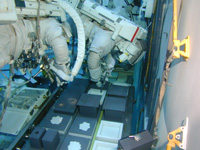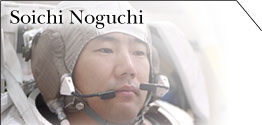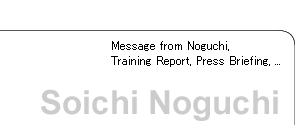Astronaut Noguchi's Training Report, #12
Space Shuttle to Be Reborn - Measures Toward Return to Flight -
Last Updated: November 11, 2004
Hello, my friends in Japan. This is Noguchi in Houston.
In this report I will tell you about the technical approach toward the Space Shuttle's return to flight, focusing on how safety measures have changed since the Columbia accident.
Recommendations by Columbia Accident Investigation Board and NASA's Responses
As everybody knows, STS-107 Space Shuttle Columbia, on her way home after two weeks of mission, broke up over Texas on the 1 February 2003. After the accident, the Columbia Accident Investigation Board (CAIB) made their determinations and issued the CAIB Report last summer. In the report, the CAIB presented RTF Recommendations to NASA; the conditions to be cleared for the Space Shuttle to Return To Flight (RTF). Since then, NASA has combined the RTF recommendations with its own measures into one volume as the RTF Plan, and has continuously revised it.
Five Primary Measures for Space Shuttle RTF
Currently, the planned flow of safety measures for Space Shuttle RTF is as follows.
The core of the measures is Preventing Thermal Insulator Loss (1). We estimate that the direct cause of the Columbia accident was that thermal insulation of the External Tank (ET) broke off during ascent and hit and damaged the Shuttle wing's front edge. During reentry into Earth's atmosphere, hot gas then entered the wing destroying the inside of it. Therefore, the primary measure is preventing the thermal insulation from breaking off.
The thermal insulation is liable to break off right after launch, as the Shuttle body vibrates strongly. Thus, cameras mounted on the ground, in aircraft, and on the Shuttle will be used to observe the launch status (2).
When the Shuttle reaches orbit, an In-Orbit Checkout (3) will be conducted. The robot arm will be used to determine if there is any damage to the Shuttle body. If any damage is found, safety measures will be performed.
When the Shuttle body needs repair, astronauts will conduct Extra Vehicular Activity (EVA) to repair the damage (4). If the repair is not successful, the astronauts will abandon the Space Shuttle and escape to the ISS and wait for the arrival of a rescue Shuttle (5).
Safety Measures Development Status
(1) Preventing Thermal Insulation Loss
The ET has been redesigned to eliminate the use of thermal insulation, and ET manufacturing procedures have been changed to decrease the volume of the insulation to be sprayed on the ET. Since it is impossible to completely eliminate insulation loss, we estimated the volume of loss that will not damage the vehicle using the latest numerical analysis at the site.
(2) Launch-Status Observation
While ground cameras, airborne cameras, and ground radar observe the launch, astronauts aboard the Shuttle will photograph the separated external tank from the mid-deck window. Actually, my first task during the next Shuttle mission will be photographing the ET. Before the end of the first day of the mission, my photos of the ET will be down-linked to the ground.
(3) In Orbit Checkout
The Shuttle body will be checked out using the Shuttle robot arm and robot arm extension boom currently being developed for the next mission. Based on his experience, astronaut Wakata of JAXA assists the boom development test as a representative for other astronauts.
 |
| Development of Tile Repair Technique |
(4) Repair
If Shuttle thermal insulation tiles or the front edge of the wing are damaged, we will conduct emergency repair by EVA in the zero-gravity space environment. I spend most of my energy on this development test as a member of the main EVA crew. Since this is a new task in Space Shuttle history, we are struggling with technical difficulties such as developing repair material and repair procedures.
(5) Escape to the ISS
To ensure the safety of the astronauts, they will abandon the Shuttle and escape to the ISS if all of the safety countermeasures shown above fail. At present, two astronauts are in the ISS for a long-term stay. However, the ISS is capable of accommodating nine people, including the seven extra Shuttle crew members, for two months, while a rescue Shuttle is prepared to bring the crew back to Earth.
What do you think? I hope you understand that NASA is earnestly trying to ensure the safety of manned flight by combining various measures. In my next report, I will focus on my efforts to explain them more precisely.





